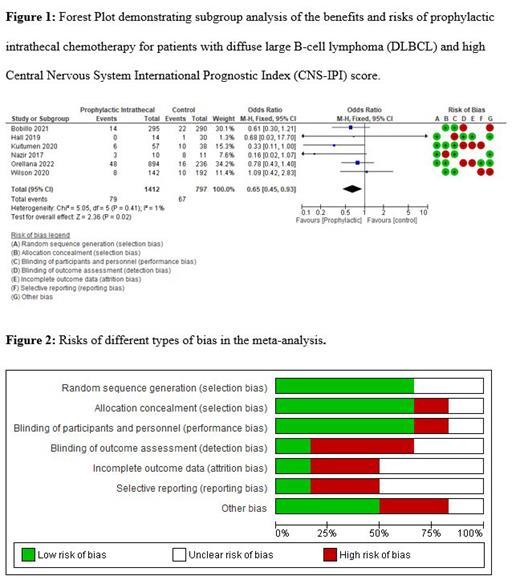Introduction
Diffuse large B cell lymphoma (DLBCL) with a high CNS-IPI score poses an increased risk for relapse involving the central nervous system (CNS). Despite various studies seeking to validate the use of CNS prophylaxis, including intrathecal chemotherapy, results have been equivocal. This ambiguity may be partly attributed to the lack of prospective data, patient heterogeneity, limited sample sizes, and outdated methodologies in pre-rituximab studies. Consequently, administering CNS prophylaxis with intrathecal chemotherapy is not a standardized practice, and decisions are often based on individual factors such as anatomical location, disease stage, and specific case characteristics.
Methods
This systematic review and meta-analysis were conducted and reported using the PRISMA guidelines. A thorough search was conducted across multiple online databases, including Google Scholar, Science Direct, PubMed, Cochrane, CINAHL, EMBASE, ProQuest Dissertation and Theses, ISI web of knowledge, PsycINFO, and Embase for articles on this topic. The date range of the articles included was between 2013-2023 and were limited to English language, peer-reviewed articles, cohort studies, retrospective studies & randomized controlled trials. The inclusion and exclusion criteria for studies helped to determine suitable studies
Results
Out of 179 studies retrieved from the database search and 2 from other studies' reference lists, 6 met the inclusion criteria for qualitative and quantitative analysis. Data from 2209 patients in these 6 studies was analyzed using a random-effects model to perform a subgroup analysis of the benefits and risks of prophylactic intrathecal chemotherapy for patients with DLBCL and a high CNS-IPI score. The results demonstrated a significant improvement in overall treatment success, with a difference of 0.60 (95% Confidence Interval, 0.45 to 0.93) on a 0-10 Visual Analogue Scale (VAS). The heterogeneity of the studies was determined to be significant (P=0.02), further substantiating the positive impact of prophylactic intrathecal chemotherapy on the therapy success rate for DLBCL patients with high CNS-IPI scores.
Conclusion
Our review elucidates that intrathecal chemotherapy as a prophylactic measure can reduce the rate of CNS relapse and enhance overall survival for patients with DLBCL possessing a high CNS-IPI score. However, it underscores the necessity to thoroughly assess each patient's unique clinical situation when determining if intrathecal chemotherapy is the appropriate therapeutic approach.
Disclosures
No relevant conflicts of interest to declare.


This feature is available to Subscribers Only
Sign In or Create an Account Close Modal